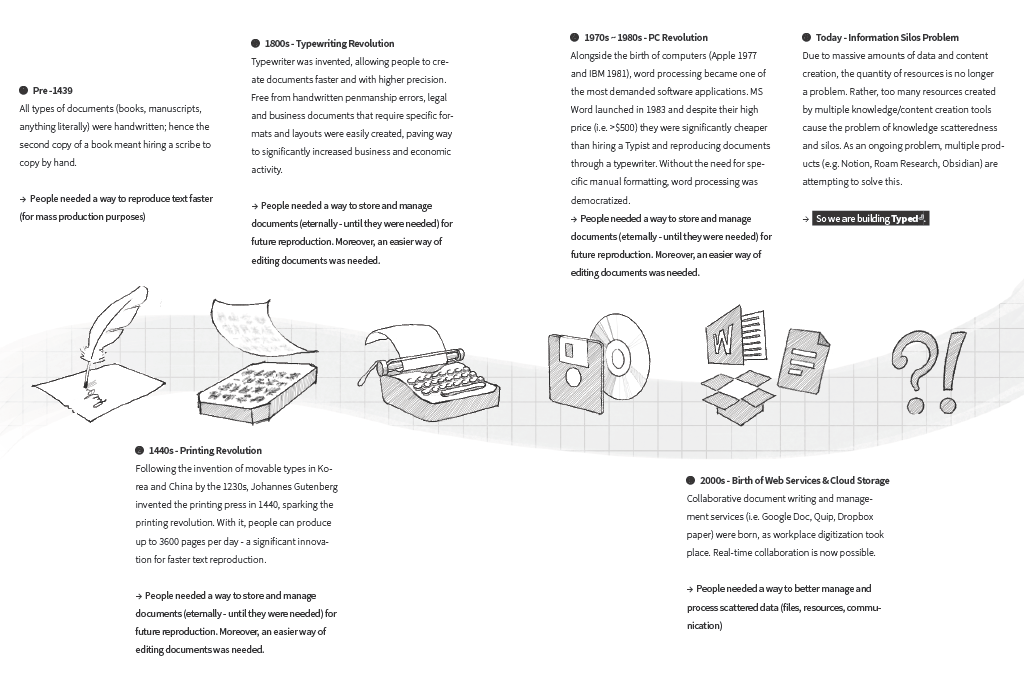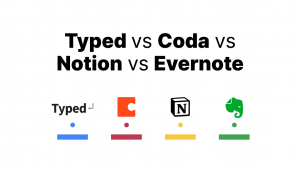Productivity in today’s information economy is defined by the ability to search, process, and generate knowledge of quality — with speed. With increased connectivity and massive amount of data being generated by over 5 billion internet users today, the ability to “focus on signal over noise” is demanded more than ever as the quantity of available information is no longer a problem but selectively filtering out information that is highly relevant to one’s purpose and context remains difficult.
Rapid digitization of the workplace brought on drastic improvements for knowledge management and work collaboration, yet new problems native to digital workflow began to arise. Just like traditional forms of physical file storage, cloud storage applications and the file-sharing services eventually, inevitably fall into the trap of cluttered yet scattered resources. The issue is exacerbated due to the provision of multiple storage applications — it’s similar to having multiple cabinets in multiple locations. To sum up, three primary factors paved way to people’s underserved needs in terms of knowledge management.
- Increase in the % of DIgital Natives (Presneky, 2001) in workplace — reapid shift behavior and demand regarding digital resource management
- Consequences of aggresive user value chain decoupling in the productivity market — too many micro SaaS competing for the time and attention of a single user
- Exponential increase of digital forms information and knowledge due to user generated contents shared through the web.
The aforementioned factors are primarily driven by the change in user behavior, which has constantly evolved throughout history. The need for productivity and efficiency in order to achieve a specific goal has always been in demand, regardless of what that goal may be. From handwritten manuscripts all the way to resource-heavy digital documents today, continuous transformation of people’s needs were the main driving forces of technological advancements. Let’s take a brief look into the evolution of user needs and how corresponding solutions were brought upon, through the diagram below.

Reality of Current Workspace
Ever since the digitization of the workplace, search has become an essential part of the daily tasks of knowledge workers. Even beyond the workplace, efforts to democratize information and increase the accessibility to knowledge placed search at the center of this information economy. Over 1.2 trillion web searches on Google Search (which has >92% of the search engine market share) that occur annually demonstrate the importance of information cu- ration in this data rich era. However, it is a modern problem that there is too much information one can effectively process, and modern problems require modern solutions.

Searches that result in finding the right information for one’s specific purpose are worth the research time and effort, yet a significant amount of time is wasted on re-finding previously accessed information and searching for specific documents that one created in the past. As digital collaboration become the standard of multiple industries today and collaborative outputs (i.e. documents) increase exponentially, time spent on searching for content and information created by colleagues is skyrocketing. The availability of a myriad of digital collaboration tools (i.e. communication, task management, file sharing) in the market definitely gives organizations more options and opportunities to increase productivity and efficiency of workflow, yet the inability to cross-communicate between these tools and information silos created by the current form of knowledge management system are exacerbating the problem of “scatteredness” in digital workflow.
Problems with Current Knowledge Management Systems/Practice
Scatteredness of resources and knowledge due to increased options
Following the concept of decoupling by Thales Teixeria, many micro SaaS broke the links between customer activities that have traditionally been ser- viced together and focused on a narrow portion of the customer value chain. This way, these new products were able to focus on a much specific pain point of the user and provide a superior solution and experience. As this phenomenon continued, a market in which the best products win was established and customers benefited from the increased number of quality options that were previously unavailable – more power to the users.
However, the increased number of options gradually paved way into unfavorable consequences. Primarily digital files and resources, which are the prima- ry artifacts of work, were severely scattered throughout multiple file storage locations (i.e. local and cloud) and file-sharing applications (i.e. email, chat app, etc.). The lack of a single integrated entity to store and share digital files started to cause a disconnection between the participants of digital collaboration. As document work become increasingly data driven, knowledge workers spend an average of 2.5 hours in searching for resources and information per work day. On average, search happens 60 times a day, 1200 times a month, meaning knowledge workers spend more time in searching for information as opposed to creation itself. Based on a study by the IDC, 30% of a knowledge worker’s time is spent in searching external data and 60% of the workers feel frustrated due to the need to find files repetitively. Moreover, 39% of the workers experience difficulty in managing resources efficiently. Annually $25 million loss occurs given an organization with a 1000 employees due to lost files and time spent on searching (McKinsey, 2012).

Information silo due to structural limitations
In addition to the unexpected adverse effects of aggressive decoupling, the current hierarchical tree structure of the folder system is gradually beginning to show it’s limitations as the amount of data and information stored and man- aged by an individual / digital native is increasing drastically. As mentioned by Ivan Zhao (Founder of Notion), all the knowledge and workflows are trapped in different “silos” and the best people can do is to duct-tape everything together, previously with emails, nowadays with Slack. Relationship between files cannot be easily established with the current structure of folder systems; hence knowledge management becomes difficult and complex in proportion to the number of files stored. The OS’s default search bar serves as the best solution to the current file structure, yet two problems remain:
- Finding files in the ever increasing cloud based applications (as aforemen- tioned in the previous section) is beyond the reach of OS’s search bar – hence services like Command E are on the rise.
- Users may not remember the related metadata of the file they are looking for (i.e. title, keywords, etc.)
Due to information silos, knowledge workers are not only facing difficulties in terms of searching specific files but also creating files that already exist. An annual $5 million dollar loss due to inefficiencies caused by repetitive creation of documents given an organization of 1000 employees (McKinsey, 2012). Moreover, Dumais and colleagues at Microsoft Research observed that much knowledge work involves integrating and re-using information that has previously been created or accessed. Information silos is creating huge inefficiencies in the workplace that is exponentially increasing as the number of digital files created by an organization organically increases. Hence Typed aims to solve this problem of scatteredness and isolation of files, especially those utilized for document writing, through our proposed knowledge network.



